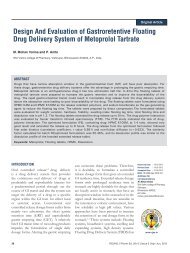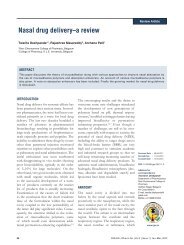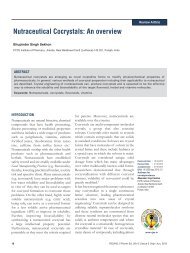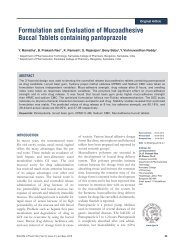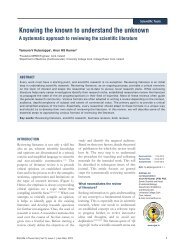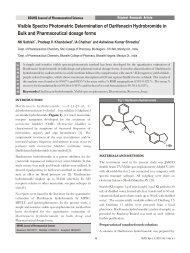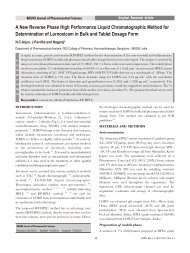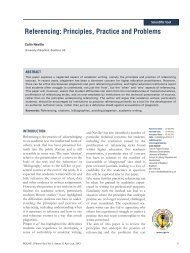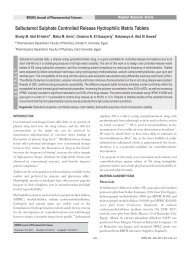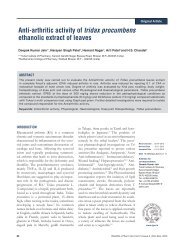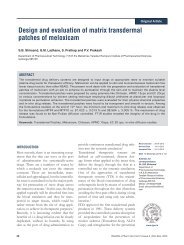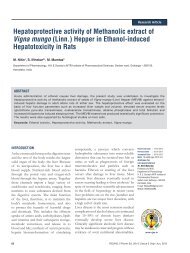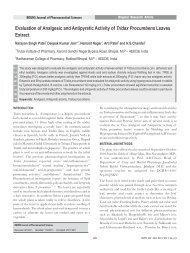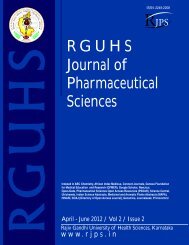Chitosan Loaded Mucoadhesive Microspheres of Gliclazide - Journal
Chitosan Loaded Mucoadhesive Microspheres of Gliclazide - Journal
Chitosan Loaded Mucoadhesive Microspheres of Gliclazide - Journal
You also want an ePaper? Increase the reach of your titles
YUMPU automatically turns print PDFs into web optimized ePapers that Google loves.
Prakash Rao B et al./ Formulation and Evaluation <strong>of</strong> <strong>Mucoadhesive</strong> Buccal Drug Delivery System <strong>of</strong> Metoprolol Tartrate by Using Central Composite Design<br />
negative effect and factor B has more significant negative<br />
effect than that <strong>of</strong> factor A on percentage MT release at 8<br />
hours. In another words, at high level <strong>of</strong> A percentage release<br />
has high value at all level <strong>of</strong> factor B which indicates factor A<br />
helps more release <strong>of</strong> drug.<br />
Effect <strong>of</strong> Variables on Bioadhesive Strength<br />
Bioadhesion is generally understood to define the ability <strong>of</strong> a<br />
biological or synthetic material to “stick” to a mucous<br />
membrane, resulting in adhesion <strong>of</strong> the material to the tissue<br />
20<br />
for a protracted period <strong>of</strong> time . In general, bioadhesion is<br />
considered to occur in three major stages: wetting,<br />
interpenetration, and mechanical interlocking between<br />
22<br />
biological tissue and polymer . Several polymer and<br />
hydrophilic macromolecules containing groups able to form<br />
hydrogen bonds have showed good adhesion property that<br />
seems to be enhanced by the incorporation <strong>of</strong> amine and<br />
23<br />
carboxylic groups . The strength <strong>of</strong> bioadhesion is affected<br />
by various factors such as molecular weight <strong>of</strong> polymer,<br />
contact time with mucus, swelling rate <strong>of</strong> polymer, and<br />
22<br />
biological membrane used in the study . Water uptake<br />
process produces polymer swelling and improves the<br />
consolidation step that increases the mobility <strong>of</strong> molecules<br />
and facilitates that interpenetration with the biological tissue<br />
layer. So, the polymer swelling is a property related to the<br />
23<br />
bioadhesion <strong>of</strong> the system . The constant and regression<br />
coefficient for bioadhesive strength are as follow:<br />
R = + 26.40149 + 0.066170 * A + 0.064012* B + 5.42857E-<br />
2<br />
004 * A * B<br />
The linear model F-value <strong>of</strong> 6.54 and p value 0.0122 implies<br />
the model is significant. Values <strong>of</strong> "Prob > F" less than 0.0500<br />
indicate model terms are significant. In this case (Table 4) A,<br />
cabopol and B, HPC are significant model terms . (Fig. 7) rep<br />
resent the observed response values compared to that <strong>of</strong><br />
predicted values. The effect <strong>of</strong> A and B can be further<br />
elucidated with the help <strong>of</strong> response surface plot (Fig 8). Both<br />
the factor A and B have an synergetic effect on the<br />
bioadhesive strength as AB factor has positive effect. At high<br />
level <strong>of</strong> factor A gave slightly higher value <strong>of</strong> bioadhesive<br />
strength than that <strong>of</strong> factor B. If A kept high level and at all<br />
levels <strong>of</strong> B bioadhesive strength was observed slightly higher<br />
values.<br />
As increase the concentration <strong>of</strong> factor A and B increases the<br />
bioadhesive strength. Carbopol gives slightly higher<br />
bioadhesive strength, when compare to the HPC due to high<br />
molecular weight, water dispersibility, polymer chain<br />
flexibility for chain interpenetration and diffusion with mucin.<br />
The carbopol forms hydrogen bond with mucin due to the<br />
21<br />
presence <strong>of</strong> many carboxylic groups and its shows higher<br />
bioadhesive strength than HPC.<br />
151<br />
Effect <strong>of</strong> formulation variables on T 50%<br />
The value <strong>of</strong> T ranges from the 4.17 to 6.46 hours (Table 4).<br />
50%<br />
The increased T was observed at high concentrations <strong>of</strong><br />
50%<br />
polymers. The constant and regression coefficient for R3 T<br />
50%<br />
are as follows:<br />
R = +3.25759 + 0.012952*A + 0.01551*B<br />
3<br />
The linear model was found to be significant for the time for<br />
50% <strong>of</strong> drug release. The Model F-value <strong>of</strong> 48.90 and value<br />
<strong>of</strong> p is less than 0.000100 indicate the model is significant.<br />
Lack <strong>of</strong> fit for the model is not significant as F-value is 1.42<br />
and p value is 0.3817. Both the factors have positive effect<br />
Fig. 7: Correlation between actual and predicted values f<br />
or bioadhesive strength<br />
Fig. 8: Response surface plot showing the effect <strong>of</strong> factor<br />
A (carbopol) and factor B (HPC) on bioadhesive strength<br />
RJPS, Jul - Sep, 2011/ Vol 1/ Issue 2



